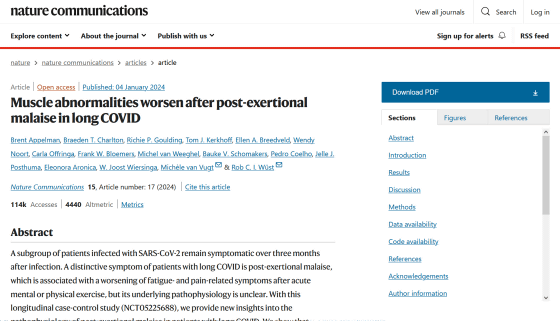Mitochondrial dysfunction may be influencing the aftereffects of the new coronavirus, ``long COVID,'' which causes fatigue and decreased exercise ability

Muscle abnormalities worsen after post-exertional malaise in long COVID | Nature Communications
https://www.nature.com/articles/s41467-023-44432-3

Long Covid causes changes in body that make exercise debilitating – study | Coronavirus | The Guardian
https://www.theguardian.com/world/2024/jan/04/people-with-long-covid-should-avoid-intense-exercise-say-researchers
Long COVID: damaged mitochondria in muscles might be linked to some of the symptoms
https://theconversation.com/long-covid-damaged-mitochondria-in-muscles-might-be-linked-to-some-of-the-symptoms-220821
Symptoms caused by Long COVID range from physical to mental, but about half of the symptoms, such as energy depletion, muscle weakness, muscle pain, and autonomic nervous system imbalance, are caused by myalgic encephalomyelitis/chronic fatigue syndrome ( It meets the diagnostic criteria for ME/CFS) .
The main characteristic of ME/CFS is ``post- exertional fatigue, '' in which symptoms worsen after slight physical, mental, or emotional exertion. Post-exertional fatigue can take days to weeks to resolve and is a major impediment to people suffering from long-COVID going about their daily lives and returning to work. However, although post-exertional fatigue has a serious impact on patients, its mechanisms are not fully understood.

Therefore, a research team from
The research team had participants perform a cycling test in which they pedaled an exercise bike for 10 to 15 minutes, and performed skeletal muscle biopsies and blood samples one week before and the day after the test. Cycling tests confirmed that Long COVID patients had lower muscle strength and lower oxygen uptake despite exerting the same amount of effort as healthy subjects. This is consistent with previous research showing that patients with long COVID have significantly reduced exercise capacity.
Analysis of muscle tissue samples taken from subjects revealed that long COVID patients had a higher proportion of fast twitch glycolytic muscle fibers (fast twitch fibers/white muscle) in their muscles. Fast-twitch muscle fibers are capable of high-intensity contractions in short periods of time, but because they have few mitochondria that produce adenosine triphosphate (ATP), which is the energy source for cells, they are extremely susceptible to fatigue.
As a result of investigating mitochondria in muscle fibers, it was found that mitochondrial function decreased with exercise in Long COVID patients. This suggests that long COVID patients not only have reduced exercise capacity, but also damage to their muscle tissue during exercise. Furthermore, it was found that the muscles and blood of Long COVID patients had fewer molecules necessary for the glycolytic system , which mitochondria use to produce energy.
When muscle mitochondria are malfunctioning, muscle cells cannot produce enough energy to meet the body's demands. It has been suggested that this may be the reason why Long COVID patients' symptoms worsen after exercise.

In addition to mitochondrial dysfunction, it was shown that there are many 'microclots' in the muscle tissue of Long COVID patients. Previous studies have suggested that long COVID symptoms may be caused by microthrombi blocking capillaries, but no evidence was found that microthrombi actually block capillaries. About.
We also found that the numbers of
The results of this study support a growing body of research showing abnormalities in metabolic, muscle, and immune function in patients with long COVID and ME/CFS. Furthermore, it has been suggested that treatments targeting mitochondria may help improve symptoms.
Several compounds, such as coenzyme Q10 (ubiquinone), have already been shown to have a positive impact on mitochondria, and may be able to activate mitochondria in Long COVID patients. However, further research is needed to know whether these compounds actually have an effect on long COVID.
Additionally, while typical rehabilitation gradually increases the intensity of exercise to build recovery and athletic capacity, patients with long COVID experience significant post-exercise damage. Therefore, this study highlights the need for caution in developing rehabilitation strategies for long-COVID patients.

Related Posts:
in Science, Posted by log1h_ik







